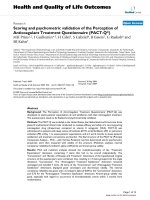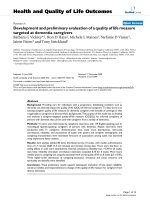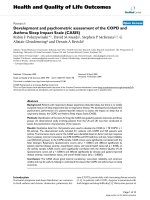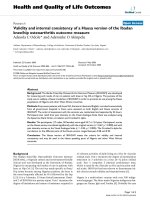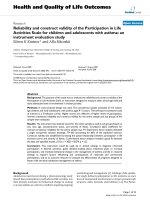Báo cáo hóa học: "Fabrication and magnetic properties of granular Co/porous InP nanocomposite materials" ppt
Bạn đang xem bản rút gọn của tài liệu. Xem và tải ngay bản đầy đủ của tài liệu tại đây (603.18 KB, 6 trang )
NANO EXPRESS Open Access
Fabrication and magnetic properties of granular
Co/porous InP nanocomposite materials
Tao Zhou
1
, Dandan Cheng
1
, Maojun Zheng
1*
,LiMa
2
and Wenzhong Shen
1
Abstract
A novel Co/InP magnetic semiconductor nanocomposite was fabricated by electrodeposition magnetic Co
nanoparticles into n-type porous InP templates in ethanol solution of cobalt chloride. The content or particle size of
Co particles embedded in porous InP increased with increasing deposition time. Co particles had uniform
distribution over pore sidewall surface of InP template, which was different from that of ceramic template and may
open up new branch of fabrication of nanocomposites. The mag netism of such Co/InP nanocomposites can be
gradually tuned from diamagnetism to ferromagnetism by increasing the deposition time of Co. Magnetic anisotropy
of this Co/InP nanocomposite with magnetization easy axis alo ng the axis of InP square channel was well realized by
the competition between shape anisotropy and magnetocrystalline anisotropy. Such Co/InP nanocomposites with
adjustable magnetism may have potential applications in future in the field of spin electronics.
PACS: 61.46. +w · 72.80.Tm · 81.05.Rm · 75.75. +a · 82.45.Aa
Introduction
The fabrication and magnetic properties of magnetic
nanomaterials or nanocomposites have been the center
of attr action amo ng researchers, due to their pot ential
applications in high-density data storage devices, mag-
neto-optical sensors, spint ronic devices, and interesting
fundamental physical phenomena [1-8]. Particularly, elec-
trodeposition of magnetic nanoparticles, nanowires, and
nanotubes in ordered nonmagnetic templates has
attracted great attention because of its low cost, preferred
yield of order magnetic nanomaterials, and size-adjusta-
ble properties [2,4,5,9-20]. The most popular template is
anodic alumina oxide (AAO) membrane because of its
uniform channel arrays and chemical inertness, which
has been widely used for producing magnetic nanostru c-
tures, including cobalt ferrite nanodot arrays [13], Fe, Co,
and Ni nanowires, nanotubes, and nanoparticles arrays
[5,8,14-19], FeNi ferromagnetic alloy, CoPt nanotubes
[9], and so on. The growth and magnetic properties of
magnetic nanomaterials in AlN, MgO, polymer tem-
plates, and superlattice matrices w ere also reported
[21-25]. Up to now, both theoretical and experim ental
works have focused mainly on insulation templates, while
there has not been much study cond ucted on the grow th
of magnetic nanomaterials in semiconductor templates.
Recently, electrodeposition of Fe, Co, Ni, and FeNi alloy
into porous silicon semiconductor matrix has been
studied [11,26-29]. It was found that the novel magneti-
zation behaviors of these nanocomposite materials
depended on deposits and matrices. For example, Granit-
zer et al. [29] found a new twof old switching of magn etic
hysteresis curve in Ni/porous silicon composites. T here-
fore, electrochemical deposition of ferrom agnetic metals
into semiconductor templates and investigation of their
magnetic properties may provide a new avenue for nano-
fabrication and have important applications ranging from
magnetic sensing to the field of spin electronics [5,6,29].
In additi on, owing to i ts direct band gap and enhanced
nonlinear optical response, increasing i nterest h as been
focused on porous InP because of its potential applica-
tions i n nanoscaled Schottk y dio des, waveguides, solar
cells, and for fabricating nanocomposite materials
[30-34]. However, to our knowledge, there are no reports
on the composite between porous InP matrix and mag-
netic materials. F urthermore, as a typical ferromagnetic
materials, Co nanostructures, especially for granular Co,
embedded in nonmagnetic matrices have be en widely
studied, where th e matrices most f ocused were of th ree
* Correspondence:
1
Laboratory of Condensed Matter Spectroscopy and Opto-Electronic Physics,
and Key Laboratory of Artificial Structures and Quantum Control (Ministry of
Education), Department of Physics, Shanghai Jiao Tong University, Shanghai,
200240, People’s Republic of China
Full list of author information is available at the end of the article
Zhou et al. Nanoscale Research Letters 2011, 6 :276
/>© 2011 Zhou et al; licensee Springer. This is an Open A ccess article distributed under t he terms of the Creative Commons Attribution
License ( /by/2.0), which permits unrestricted use, distribution , and reproduction in any medium,
provided the original work is prope rly cited.
kinds: metallic matrices (Cu, Ag and Nb) [35-38]; cera-
mic matrices (Al
2
O
3
and AlN) [5,23,3 9]; and polymeri c
matr ices [22,24]. In this article, we report on the electro-
chemical deposition of Co into n-type porous InP semi-
conductor matrix based on organic solution of cobalt
chloride, where the organic solution, i.e., ethanol solu-
tion, was applied to protect Co from oxidization. The
structure and magnetic properties of such Co/InP nano-
composites were also investigated.
Experiment details
Co/InP magnetic semiconductor nanocom posites were
fabricated by one-step electrodeposition of Co particles
onto n-type porous InP templates. Figure 1 shows the
schematic illustration of the fabrication of Co/InP com-
posite structure. First, the n-type p orous InP template
was prepared by a two-step etching method [40]. The
starting material was Sn-doped InP (>1 × 10
18
cm
-3
)
wafer, which was first etched at a constant voltage of 8 V
in 7.5% HCl aqueous solution for 30 s. Next , the speci-
men was immersed in a mixture of pure HCl and H
3
PO
4
(HCl:H
3
PO
4
= 1:3 v/v) for a few minutes to remove the
top irregular layer to obtain n-type porous InP templates
with uniform and square pore arrays. This was followed
by electrochemical deposition of Co particles onto por-
ous InP templates, performed using a three-electrode
cell, employing a porous InP template as the working
electrode and a graphite plate counter-electrode. The
reference electrode was a saturated calomel electrode
(SCE), isolated from the solution by a s alt bridge. The
deposition bath was 0.1 M/L CoCl
2
ethanol solution, pre-
pared by dissolving CoCl
2
in ethanol. Before the deposi-
tion of Co, the porous InP template was immers ed in th e
bath about 1 h to allow the solution completely wet the
inner pore walls. The applied potential was kept at 2.0 V
with resp ect to SCE. After the deposition of Co, the sam-
ple wa s cl eaned by de-ionized water, dried in N
2
atmo-
sphere, and then kept in anhydrous ethanol. All the
experiments were performed at room temperature.
The morphology of Co/InP nanocomposite structures
was subsequently studied by field-emission scanning
electron microscope (FE-SEM). The composition and
crystallographic structure of samples were investigated
by energy dispersive X-ray spectrometer (EDS) system
attached to SEM and X-ray diffraction (XRD) with Cu
Κ
a
radiation (l = 1.54 Å). Physical property measure-
ment system was applied to characterize magnetic prop-
erties of such Co/InP nanocomposites at 300 K with
magnetic field sweeping from -15 to 15 KOe.
Results and discussions
Structure characterization of Co/InP nanocomposites
Figure 2a shows the typical FE-SEM image of n-type por-
ous InP template with nearly uniform and square pore
arrays. In order to study the growth process of Co in por-
ous InP semiconductor matrix, Co/InP nanocomposites
with different deposition times were prepared. The cross-
sectional morphologies of different samples are shown in
Figure 2b, c, d. There is almost no Co in the inner channel
wall of the InP matrix when the deposition time is 30 s, as
shown in Figure 2b. When the deposition time increases
to 90 s, it was found that a small amount of Co nanoparti-
cles uniformly distribute on the whole inner channel walls
of the InP template (Figure 2c). On further increasing the
deposition time, the needle-shaped Co forms on the inner
pore walls of InP as shown in Figure 2d. It is noted that
Co particles prefer to uniformly distribute over the chan-
nel wall surface of the InP template than gather at the bot-
tom of channel, wh ich may result from conductivity of
n-type porous InP template. In other words, the deposition
of metallic Co particles may occur at any position of the
pore sidewall surface of InP template (as shown by t he
schematic of Figure 1), which is different fro m the “bot-
tom-up” growth mechanis m in the ins ulation templat es,
such as AAO. Since the channel walls of the insulation
templates a re stable and nonconductive in the solution,
the growth by electrodeposition is always from the bottom
to the opening when a conductive layer is fabricated at the
bottom side of the insulation channels [9]. Therefore,
adjustable electrodepositions may be realized by tuning
the conductivity and reactivity of such porous InP matrix,
which may open up a new bran ch in the fabrication of
nanocomposite materials. A detailed discussion for this is
not given here because it is not the main concern for this
Figure 1 Schematic of fabrication process of Co/InP nanocomposite structure.
Zhou et al. Nanoscale Research Letters 2011, 6 :276
/>Page 2 of 6
article; similar studies in porous silicon matrix have been
summarized by Ogata et al. [41].
It is also noted that there is oxygen in the first pro-
duct prepared by electrodeposition in aqueous solution
of cobalt chloride under same conditions (this EDS
spectrum is not illustrated in this article), which indi-
cates that Co has been oxidized. Therefore, ethanol
solution is chosen to fabricate Co/InP nanocomposites,
the composition of which is a nalyzed by EDS as shown
in Figure 3a, where only In, P, and Co exist (without the
presence of oxygen), indicating that the pure Co nano-
particles have been successfully embedded in the porous
InP semiconductor matrix and the ethanol solution
effectively protects Co from o xidization. To further
investigate the structure and compositio n of such Co/
InP nanocomposites, the XRD pattern has been mea-
sured and shown in Figure 3b, where two strong diffrac-
tion peaks at 2θ = 30.52° and 63.41° are, respectively,
identified as (200) and (400) of the porous InP template
consistent with the previous results [34,40]. The other
four peaks at 2θ = 41.59°, 44.26°, 47.39°, and 75.89°
correspond to hexagonal Co (100), (002), (101), and
(110), respectively. This further confirms that the
obtained sample is that of Co/InP nanocomposites.
Magnetic properties of Co/InP nanocomposites
Figure 4 shows field-dependent magnetization (M-H)
curves of such Co/InP nanocomposites, where the
applied magnetic field is perpendicular to the surface of
the InP template or parallel to the axis of InP channel.
For the deposition time of 30 s, the Co/InP nanocompo-
sit e presents diamagnetism as shown in Figure 4a, which
is ascribed to the complete diamagnetism of n-type por-
ous InP template according to the above SEM analysis
and the M-H curveofpureInP(Figure4b).Whileweak
ferromagnetism is detected for the sample with the
deposition time of 90 s (Figure 4a), with the deposition
time of 5 min, the Co/InP nanocomposite exhibits visible
hyster esis lo op as shown in Figure 4b. This indicates that
the Co particles embedded in the InP matrix dominate
the magnetic behavior of this Co/InP nanocomposite
when the content of Co gradually increases due to the
Figure 2 FE-SEM images of the cross section of Co/InP nanocomposite structure with different deposition times of Co: (a) 0 s, (b) 30 s,
(c) 90 s, and (d) 5 min.
Zhou et al. Nanoscale Research Letters 2011, 6 :276
/>Page 3 of 6
strong ferromagnetism of Co. In a word, the magnetism
of such Co/InP magnetic semiconductor nanocomposite
is completely determined by the depo sition time of Co.
The exhibited ferromagneti sm under the room tempera-
ture, originating from the Co particles embedded in the
n-type porous InP matrix, is different from that of the
superparamagnetism of Co particles in Cu and dendrimer
matrix [22,36].
Figure 5 shows magnetic hysteresis loops of Co/InP
composite str ucture with the deposition time of 5 min
for both perpendicular and parallel o rientations, where
H
//
and H
⊥
represent the field applied perpendicular and
parallel to the surface of the InP template, respectively.
Typical coercivities with H
c⊥
= 775 Oe and Hc
//
= 644
Oe are clearly found in the inset of Figure 5, indicating
the enhanced coercivity compared with that of the bulk
Co (10 Oe). The relatively larger coercivity in perpendi-
cular orientation suggests weak anisotropy of the system,
i.e., magnetizat ion easy axis is perpendicular to the
surface of InP template. This magnetic anisotropy of the
system is determined by the relatively strong-shape ani-
sotropy of Co nanoparticle arrays embedded in the por-
ous InP matrix compared with the magnetocrystalline
anisotropy of hexa gonal C o particle. Furthermore, both
magnetization curves for perpendicular and parallel are
sheared as shown in Figure 5, indic ating the existence of
inter-particle interactions, which is also manifested by
the low squareness ratios, (M
r
/M
s
)
⊥
=0.34and(M
r
/M
s
)
//
= 0.36. Si milar sheared hysteresis loops w ere also found
in Co/ZrO
2
, Co/AAO, and Ni/AAO na nocomposite
materials [2,14,17]. In brief , magnetic anisotropy in the
Co/InP nanocomposite structure with easy axis perpendi-
cular to the surface of In P matrix is compatible with that
of typical magnetic nanostructures such as nanowires
and nanotubes [8,14,16,20,21,29], i.e., the magnetization
easy axis is along the long axis of nanostructures, which
is the r esult of the competition between the dominant
shape anisotropy and magnetocrystalline anisotropy.
Figure 3 The characterization of the Co/InP nanocomposite structure: (a) EDS spectrum and (b) XRD pattern.
Figure 4 Field-dependent magnetization curves (M-H) of the Co/InP nanocomposite structure, where the magnetic field is applied
perpendicular to the surface of the InP template with different deposition times of Co: (a) 30 s (square) and 90 s (solid line), (b) 5 min
(square), the inset shows the magnetization curve of the n-type porous InP template (square).
Zhou et al. Nanoscale Research Letters 2011, 6 :276
/>Page 4 of 6
Conclusion
We have reported in this article a novel Co/porous InP
magnetic semiconductor nanocomposite based on electro-
chemical deposition technique in ethanol solution of
cobalt chloride. The ethanol solution effectively protects
Co from oxidization, as confirmed by the XRD and EDS
analyses. Granular Co prefers to uniformly distribute over
the channel walls of the InP templates, which is different
from the “bottom-up” mechanism of ceramic matrix and
thereby may provide a new avenue for nanofabrication.
With the increasing deposition time of Co, the size or con-
tent of granular Co embedded in the InP template
increases, and the m agnetic behavior of such Co/InP
nanocomposites shows gradual change from diamagnetism
to ferromagnetism. The com parison of shape anisotropy
effects to magnetocrystalline anisotropy effects he lps one
to explain the magnetic anisotropy of this novel Co/InP
magnetic semiconductor nanocomposite, which may lead
to new applications in the field of spin electronics.
Abbreviations
AAO: anodic alumina oxide; EDS: energy dispersive X-ray spectrometer; FE-
SEM: field emission scanning electron microscope; M-H: field-dependent
magnetization; SCE: saturated calomel electrode; XRD: X-ray diffraction.
Acknowledgements
This study was supported by the Natural Science Foundation of China (grant
NO. 10874115 and 10734020), National Major Basic Research Project of
2010CB933702, Shanghai Nanotechnology Research Project of 0952nm01900,
Shanghai Key Basic Research Project of 08JC1411000, the Research fund for
the Doctoral Program of Higher Education of Chain, and the Graduate
Innovative Ability Training Special Fund of Shanghai Jiao Tong University.
Author details
1
Laboratory of Condensed Matter Spectroscopy and Opto-Electronic Physics,
and Key Laboratory of Artificial Structures and Quantum Control (Ministry of
Education), Department of Physics, Shanghai Jiao Tong University, Shanghai,
200240, People’s Republic of China
2
School of Chemistry & Chemical
Technology, Shanghai Jiao Tong University, Shanghai, 200240, People’s
Republic of China
Authors’ contributions
TZ par ticipated in the design of the study, carried out the experiments,
performed the statistical analysis, as well as drafted the manuscript. DDC
participated in the design of the study, carried out the experiments, and
performed the statistical analysis. MJZ participated in the design of the
study, provided the theoretical and experimental guidance, performed the
statistical analysis, and revised the manuscript. LM participated in the design
of experimental section and offered her the help in experiments. WZS gave
his help in the setting up of experimental apparatus.
Competing interests
The authors declare that they have no competing interests.
Received: 30 December 2010 Accepted: 31 March 2011
Published: 31 March 2011
References
1. Sun SH, Murray CB, Weller D, Folks L, Moser A: Monodisperse FePt
nanoparticles and ferromagnetic FePt nanocrystal superlattices. Science
2000, 287:1989-1992.
2. Bao JC, Tie CY, Xu Z, Ma Q, Hong JM, Sang H, Sheng D: An array of
concentric composite nanostructures of zirconia nanotubules/cobalt
nanowires: preparation and magnetic properties. Adv Mater 2002,
14:44-47.
3. Billas IML, Châtelain A, De Heer WA: Magnetism from the atom to the
bulk in iron, cobalt, and nickel clusters. Science 1994, 265:1682-1684.
Figure 5 Magnetic hys teresis loops of the Co/InP nanocomposit e structure w hen the magne tic filed is applied b oth parallel (circle)
and perpendicular (solid line) to the surface of the InP template with deposition time of 5 min. Inset is the magnification curve.
Zhou et al. Nanoscale Research Letters 2011, 6 :276
/>Page 5 of 6
4. Zeng H, Skomski R, Menon L, Liu Y, Bandyopadhyay S, Sellmyer DJ:
Structure and magnetic properties of ferromagnetic nanowires in self-
assembled arrays. Phys Rev B 2002, 65:134426.
5. Babonneau D, Petroff F, Maurice JL, Fettar F, Vaurés A: Evidence for a self-
organized growth in granular CoO/Al
2
O
3
multilayers. Appl Phys Lett 2000,
76:2892-2894.
6. Roultkevitch D, Tager AA, Haruyama J, Almawlawi D, Moskovits M, Xu JM:
Nonlithographic nano-wire arrays: fabrication, physics, and devices
applications. IEEE Trans Electron Dev 1996, 43:1646-1658.
7. Wernsdorfer W, Doudin B, Mailly D, Hasselbach K, Benoit A, Meir JP,
Ansermet JPh, Barbara B: Nucleation of magnetization reversal in
individual nanosized nickel wires. Phys Rev Lett 1996, 77:1873-1876.
8. Narayanan TN, Suchand Sandeep CS, Shaijumon MM, Ajayan PM, Philip R,
Anantharaman MR: The synthesis of high coercivity cobalt-in-carbon
nanotube hybrid structures and their optical limiting properties.
Nanotechnology 2009, 20:285702.
9. Han XF, Shamaila S, Sharif R, Chen JY, Liu HR, Liu DP: Structural and
magnetic properties of various ferromagnetic nanotubes. Adv Mater
2009, 21:4619-4624.
10. Chaure NB, Stamenov P, Rhen FMF, Coey JMD: Oriented cobalt nanowires
prepared by electrodeposition in a porous membrane. J Magn Magn
Mater 2005, 290-291:1210-1213.
11. Our S, Sam S, Fortas G, Gabouze N, Beldjilali K, Tighilt F: FeNi alloys
electroplated into porous (n-type) silicon. Phys Status Solidi C 2008,
5:3694-3697.
12. Rosa WO, Jaafar M, Asenjo A, Vázquez M: Co nanostructure arrays in
patterned polymeric template. J Appl Phys 2009, 105:07C108.
13. Gao XS, Liu L, Lee W, Birajdar BI, Ziese M, Alexe M, Hesse D: High-density
periodically ordered magnetic cobalt ferrite nanodot arrays by template-
assisted pulsed laser deposition. Adv Funct Mater 2009, 19:3450-3455.
14. Kartopu G, Yalçın O, Es-Souni M, Başaran AC: Magnetization behavior of
ordered and high density Co nanowire arrays with varying aspect ratio.
J Appl Phys 2008, 103:093915.
15. Ren Y, Dai YY, Zhang B, Liu QF, Xue DS, Wang JB: Tunable magnetic
properties of heterogeneous nanobrush: from nanowire to nanofilm.
Nanoscale Res Lett 2010, 5:853-858.
16. Silverberg J, Friedman A, Menon L: Growth and magnetic properties of
polycrystalline self-assembled bifurcated Co nanowires. J Nanomater
2008, 2008:782930.
17. Bao JC, Tie CY, Xu Z, Zhou QF, Shen D, Ma Q: Template synthesis of an
array of nickel nanotubules and its magnetic behavior. Adv Mater 2001,
13:1631-1633.
18. Li DD, Thompson RS, Bergmann G, Lu JG: Template-based synthesis and
magnetic properties of cobalt nanotube arrays. Adv Mater 2008,
20:4575-4578.
19. Thongmee S, Pang HL, Ding J, Lin JY: Fabrication and magnetic
properties of metallic nanowires via AAO templates. J Magn Magn Mater
2009, 321:2712-2716.
20. Maaz K, Karim S, Usman M, Mumtaz A, Liu J, Duan JL, Maqbool M: Effect of
crystallographic texture on magnetic characteristics of cobalt nanowires.
Nanoscale Res Lett 2010, 5:1111-1117.
21. Cao HQ, Xu Z, Sang H, Sheng D, Tie CY: Template synthesis and magnetic
behavior of an array of cobalt nanowires encapsulated in polyaniline
nanotubules. Adv Mater 2001, 13:121-123.
22. Wu HX, Zhang CX, Jin L, Yang H, Yang SP: Preparation and magnetic
properties of cobalt nanoparticles with dendrimers as templates. Mater
Chem Phys 2010, 121:342-348.
23. Zanghi D, Traverse A, Petroff F, Maurice JL, Vaures A, Dallas JP: Structural
and magnetic properties of Co/AlN multilayers. J Appl Phys 2001,
89:6329-6335.
24. García-García A, Vovk A, Pardo JA, Štrichovanec P, Magén C, Snoeck E,
Algarabel PA, De Teresa JM, Morellón L, Ibarra MR: Magnetic properties of
Fe/MgO granular multilayers prepared by pulsed laser deposition. J Appl
Phys 2009, 105:063909.
25. Fernández L, Corso M, Schiller F, Ilyn M, Holder M, Ortega JE: Self-
organized growth of high density magnetic Co nanodot arrays on a
Moiré template. Appl Phys Lett 2010, 96:013107.
26. Ronkel F, Schultze JW, Arens Fisher R: Electrical contact to porous silicon
by electrodeposition of iron. Thin Solid Films 1996, 276:40-43.
27. Renaux C, Scheuren V, Flandre D: New experiments on the
electrodeposition of iron in porous silicon. Microelectron Reliab 2000,
40:877-879.
28. Aravamudhan S, Luongo K, Poddar P, Srikanth H, Bhansali S: Porous silicon
templates for electrodeposition of nanostructures. Appl Phys A 2007,
87:773-780.
29. Grantizer P, Rumpf K, Surnev S, Krenn H: Squid-magnetometry on
ferromagnetic Ni-nanowires embedded in oriented porous silicon
channels. J Magn Magn Mater 2005, 290:735-737.
30. Reid M, Cravetchi I, Fedosejevs R, Tiginyanu IM, Sirbu L, Boyd Robert W:
Enhanced nonlinear optical response of InP(100) membranes. Phys Rev B
2005, 71:081306.
31. Hasegawa H, Sato T, Kaneshiro C: Properties of nanometer-sized metal ±
semiconductor interfaces of GaAs and InP formed by an in situ
electrochemical process. J Vac Sci Technol B 1999, 17:1856-1866.
32. Langa S, Lölkes S, Carstensen J, Hermann M, Böttger G, Tiginyanu IM, Föll H:
Engineering the morphology of porous InP for waveguide applications.
Phys Status Solidi C 2005, 2:3253-3257.
33. Tiginyanu I, Monaico E, Monaico E: Ordered arrays of metal nanotubes in
semiconductor envelope. Electrochem Commun 2008, 10:731-734.
34. Cheng DD, Zheng MJ, Yao LJ, He SH, Ma L, Shen WZ, Kong XY: The
fabrication and characteristics of indium-oxide covered porous InP.
Nanotechnology 2009, 20:425302.
35. Guevara J, Llois AM, Weissmann M: Large variations in the magnetization
of co clusters induced by noble-metal coating. Phys Rev Lett 1998,
81:5306-5309.
36. Cezar JC, Tolentino HCN, Knobel M: Structural, magnetic, and transport
properties of Co nanoparticles within a Cu matrix. Phys Rev B 2003,
68:054404.
37. Sánchez RD, López-Quintela MA, Rivas J, Gonzá1ez-Penedo A, García-
Bastida AJ, Ramos CA, Zysler RD, Ribeiro Guevara S: Magnetization and
electron paramagnetic resonance of Co clusters embedded in Ag
nanoparticles. J Phys Condens Matter 1999, 11:5643-5654.
38. Jamet M, Dupuis V, Mélinon P, Guiraud G, Pérez A, Wernsdorfer W,
Traverse A, Baguenard B: Structure and magnetism of well defined cobalt
nanoparticles embedded in a niobium matrix. Phys Rev B 2000, 62:493.
39. Huttel Y, Gómez H, Clavero C, Cebollada A, Armelles G, Navarro E, Ciria M,
Benito L, Arnaudas JI, Kellock A: Cobalt nanoparticles deposited and
embedded in AlN: magnetic, magneto-optical, and morphological
properties. J Appl Phys 2004, 96:1666-1673.
40. Zeng AS, Zheng MJ, Ma L, Shen WZ: Formation of uniform and square
nanopore arrays on (100) InP surfaces by a two-step etching method.
Nanotechnology 2006, 17:4163-4167.
41. Ogata YH, Kobayashi K, Motoyama M: Electrochemical metal deposition
on silicon. Curr Opin Solid State Mater Sci 2006, 10:163-172.
doi:10.1186/1556-276X-6-276
Cite this article as: Zhou et al.: Fabrication and magnetic properties of
granular Co/porous InP nanocomposite materials. Nanoscale Research
Letters 2011 6:276.
Submit your manuscript to a
journal and benefi t from:
7 Convenient online submission
7 Rigorous peer review
7 Immediate publication on acceptance
7 Open access: articles freely available online
7 High visibility within the fi eld
7 Retaining the copyright to your article
Submit your next manuscript at 7 springeropen.com
Zhou et al. Nanoscale Research Letters 2011, 6 :276
/>Page 6 of 6

